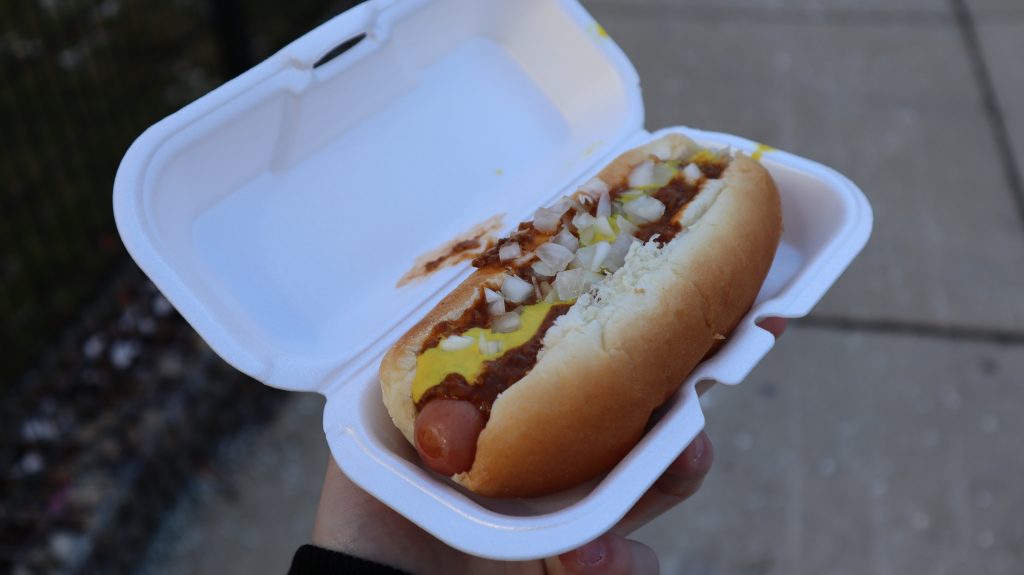CuriosiD: Why are there so many Coney Islands in Detroit?
Quinn Klinefelter March 9, 2023How a simple sandwich became a Detroit staple — and why its namesake is in New York.

Detroit delicacy, the Coney dog.
WDET’s CuriosiD series answers your questions about everything Detroit. Subscribe to CuriosiD on ApplePodcasts, Spotify, NPR.org or wherever you get your podcasts.
In this episode of CuriosiD, we answer the question…
“Why are there so many Coney Islands in Detroit?”
The short answer
Coney Island restaurants started to smother the nation’s car capitol in the early 20th century. Some Greek immigrants who arrived in the U.S. at that time passed through New York’s famed Coney Island amusement area and looked for work in Detroit’s auto industry. Instead, some began selling food to auto workers, including a new kind of hot dog dripping with Greek sauce.
A quick meal births a century-old tradition
Take a hot dog that snaps when someone bites into it, cover it with onions, tangy mustard and a special chili sauce in a steamed bun, and a simple sandwich becomes a Metro Detroit icon – the Coney dog.
But why are they all Coneys?
Some historians believe the meat of the story began in the 1900’s at a Coney Island in Jackson, Michigan.
Others say it started in Detroit around that same time period after Greek immigrant Gust Keros came to town, searching for work in the auto industry. Instead of joining a production line, he began selling food to auto workers from a small push cart.

His granddaughter, Grace Keros, says Gust made a little money and purchased an expansive shop on a Detroit corner, designed for those who wanted a quick meal.
“Downstairs in the basement was the first speakeasy in Detroit,” Keros says. “They used to come downstairs in the basement, gamble, have their drinks. Then they would be hungry, they would need to eat. Grandpa invented the Coney. The chili is a Greek chili sauce. It’s our own secret recipe.”
All the place needed was a name.
Keros says her grandfather’s thoughts turned to the Coney Island carnival lights that greeted him when he first stepped foot on U.S. soil.
“He remembers as a young man coming from a village in the mountains and seeing that amusement park when he landed in New York,” she says. “It was so amazing to him, made such an impression on him, he was so grateful that he was in America. So, American Coney Island. That’s how the name caught on.”
Keros leans across a dining table, serving a hot dog in the very same space her grandfather first turned into a red-white-and-blue-themed restaurant roughly a century ago.
She says he brought relatives from Greece to Detroit, trained them in the art of the Coney and helped them set up their own shops. His brother William took control of a narrow storefront right next door, calling it Lafayette Coney Island, complete with a long lunch counter and sea foam green décor.
And a rivalry was born, with both restaurants developing their own loyal fan base.

Lafayette or American?

A party of six squeezes into tables set inside the tight confines of the Lafayette Coney Island.
It’s a birthday present for one long-time visitor to the restaurant. He has to shout to be heard over the cascade of voices in the room, including workers in 1950’s-esque lunch uniforms yelling orders to the cooks bent over nearby grills. “Chili!” “Fries!”
“Don’t tell my wife I’m here,” the grizzled birthday boy says with a smile. “I’m supposed to be in Chicago.”
On the other side of an adjoining wall, in a far larger room, a woman taps her fingers on American Coney Island’s lunch counter.
“Where’s my hot dog at? Gimme my damn hot dog.”

Lincoln Park retiree Adrian Craw-Hill grabs a paper bag that smells like spicy chili. It’s a ritual she says she’s repeated for decades.
“I love it. Best hot dog in the world. They got a restaurant in Vegas, been there too. This is the best place to be though, because it’s the one that’s been in my life the most,” Craw-Hill says.
In the spacious nearby dining area, Oregon native David Carrigg texts pictures of his hot dog to a friend in Portland. He says the Coney aficionado told him he had to make a stop in Detroit and check out both Lafayette and American.
“So I started out next door and came over here,” Carrigg says. “This is the second one of the day.”
He opens wide and gulps a bit of the steamy hot dog, chewing slowly and wiping chili from off his chin.
“That’s pretty good. I have to say, though, I can’t tell the difference between this one and the one next door. Ha!”
A sauce, a secret, a Coney war
Not being able to tell the difference between Lafayette and American is a bit sacrilegious for owner Grace Keros. She says with Coney Islands, it’s all about the sauce. And in American’s case, she says, the homemade sauce.
“Detroit Chili. That’s our chili. We own it, we make it, we produce it. For me.”

Author Katherine Yung found that Coney sauce is considered top-secret information by its creators.
Yung and Michigan State journalism teacher Joe Grimm literally wrote the book on Coney Islands in the state. They investigated Coney dogs, tacos, pizzas, even omelets, from Flint to Port Huron and beyond.
But Grimm says the specific ingredients in any given Coney sauce were never on the menu.
“We could not get a recipe anyplace,” he says. “I went to a Coney Island in the Saginaw area. It was run by an old Greek guy and he was very proud of what he was making. I said, ‘What do you call the sauce?’ He said, ‘It’s in Greek, let me write it down for you.’ He wrote on a piece of paper what the name of the sauce was. I thought I had the solution. And I had somebody translate the paper when I got back to Detroit. All he’d written on the paper was ‘Red Sauce.’”
Grimm says Coneys caused a war among Detroit restaurant owners in the 1960’s, when they held a contest to see who had the best chili sauce.
“I think there was a bombing. I think there was a court case. And I think the court case never was resolved because people didn’t want to divulge their recipes. So, it was kind of a draw,” he says.
One saucy secret is not really a secret at all.
Many cooks cover their dogs with chili sold throughout the region by the National Coney Island chain of restaurants. Some places throw in a handful of this spice or a spoonful of that, to give it a more unique flavor. But the basic concoction is enough to drive eaters to the National chain, or so opines store manager Tony Mosqua.
He’s spent more than a decade working at National Coneys in Metro Detroit. That includes his current gig at a National restaurant near 11 Mile in Roseville, a location well-known in the area for the revolving 70-foot tall cement cone bearing its name towering above its roof.

Inside, rows of booths surround low-slung vinyl bar stools, in a very early-Elvis-style motif.
Mosqua says National owners strive for that “small diner” feel.
“People of all ages come here. After church, after football games, if they want a cream puff or just a nice hot fudge sundae,” Mosqua says. “It could be anything from a line at the door for an hour all the way to Friday night football games… And the next thing you know you got two, three high schools in the restaurant. You close at midnight, it’s quarter to 12 and there’s dang near over a hundred people still in there.”
A Coney state of mind
The Coney dog itself became a draw for customers worldwide, enticing everyone from television celebrities to the Queen of England. But it’s still kind of a secret in the New York neighborhood that gave birth to the American hot dog and the Coney name.
Charles Denson directs the Coney Island History Project in the New York City borough of Brooklyn. He knows the words to all the songs that memorialize people’s Coney Island Babies, but says the project’s research does not include anything about Coney Island hot dogs or restaurants, especially any in the Motor City.
“I’ve never heard of them and there’s no Detroit hot dog sold in Coney Island,” Denson says. “Also, putting chili on a hot dog, that’s something else that you wouldn’t see in Coney Island. It’s strictly mustard or relish. And I think some people even put ketchup on, which is a little weird.”

Back at American Coney Island, owner Grace Keros dismissively waves her hand at a plastic bottle of the offending tomato condiment.
“Only mustard on a Coney. No ketchup!”
She reaches past it for what she calls a properly-made version of the signature sandwich, overflowing with so much chili and onions customers often have to eat them with a fork.
Keros says the Coneys here are built just the way her grandfather made them more than a century ago. And, she says, that’s how customers want it.
“When I see generations of families coming in here saying, ‘My mom brought me, my dad brought me, I’m bringing my grandkid,’ that’s what makes it all worth it. And there’s not a week that goes by that we don’t hear those stories. ‘I got engaged here. I came here and had a Coney before I went and gave birth to my kid.’ That’s what it’s about.”
It’s become almost a sacred thing for Keros and, seemingly, many other restaurant owners in Metro Detroit.
If it’s not an “official” Coney in name, taste and texture – then it’s just a hot dog.
Meet the listener

West Bloomfield resident Grant Schumacher is an electrical engineer whose ravenous curiosity demanded that he discover the tasty tentacles of the truth that surround the history of Detroit’s signature food.
“I was in Montreal a couple months ago and restaurants there would call a Coney dog a Michigan dog. But it was still a Coney.”
We want to hear from you!
If there’s a saucy question you’d relish the answer to, let us know here or fill out the form below.
More from CuriosiD:
- Who made Detroit-style pizza first?
- Why does steam come out of Detroit’s streets?
- Could Detroit’s buried streams see the light of day?
Support the podcasts you love.
One-of-a-kind podcasts from WDET bring you engaging conversations, news you need to know and stories you love to hear.
Keep the conversations coming. Please make a gift today.
